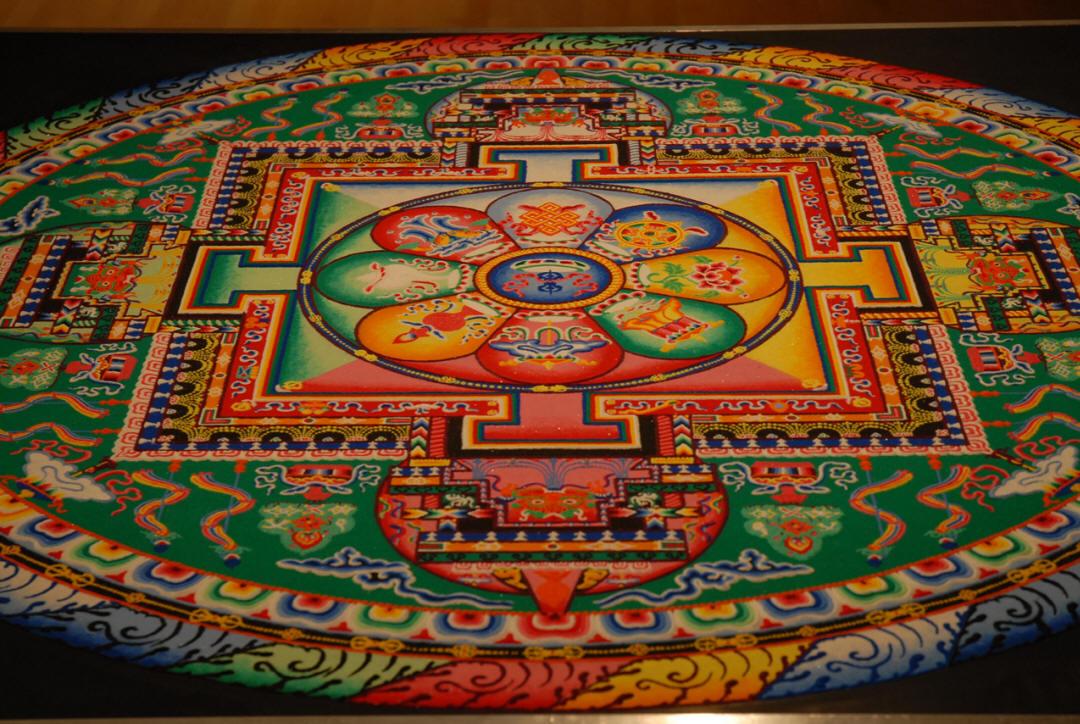Symbolism of the Mandala
Revolution of Peace, Kindness & Compassion

Click the image above to interact with the mandala. Hover over the image to learn the
meanings behind various parts of the mandala. For a list of all the parts, click the links below.
Elements
The Ring of Fire:
The outside ring of a mandala, known as the ring of fire, serves as a boundary between the outer world, full of chaos, and the sanctity found within the mandala. The mystical journey doesn’t begin until one has left samsara, the world of phenomena, and passed through the flames serving as the mandala’s barrier.
Fire, a ritual element representing the wisdom found within the mandala, is signified by stylized scrollwork found around the outer edge of the mandala.
The Ring of Vajras:
Inside the ring of fire is a second ring, known as the ring of vajras. In Sanskrit, vajras means both “thunderbolt” and “diamond.” The thunderbolt represents truth and power, and the diamond is a symbol for purity and indestructibility.
These symbols placed together within this inner ring represent the starting point of unalterable and complete essence and understanding, found within the mandala.
The Ring of the Lotus:
This third inner ring, known as the ring of the lotus, symbolizes the journey of a mystic leaving samsara and entering nirvana. The symbol of the lotus represents spiritual rebirth.
The roots of the lotus are in the mud, representing the darkness at the beginning of the mystic’s journey. The flower of the lotus is floating on clear water and opens to the sky, representing enlightenment at the end of the journey.
The Inner Square:
The square found inside the mandala, past the inner rings, looks like a traditional Indian temple and represents the palace of the deity. The four doors are often guarded by the Lokapalas, or the guardians of the four cardinal directions.
The Four Doors:
Above each of the four doors is a torana, an arch held up by pillars. The pillars are decorated with various spiritual symbols, and on top of the torana is a golden disk, a symbol of Buddha’s teachings known as turning the wheel of the law.
The Four Triangles:
Within the inner square, there are four triangles created by intersecting diagonal lines. Each of the triangles represents the Dhyani-Buddha families of the four directions, north (green), south (yellow), east (blue), and west (red).
The number four is also representative of completion and balance, stemming from the four seasons, four directions, and four elements.
The Center:
Found where the four triangles touch, the center of the mandala represents the core of the universe. This is where all things come from, and all things return to.
Pure wisdom is found here and splits into the four different wisdoms represented by the four triangles in the inner square. The mystic seeks to be one with this god; if achieved, he will achieve reintegration into the state of Buddhahood.
Appropriately, the number one represents unity and the initiation of a process.
Colors
Black: Signifies both ends of many spectrums, including darkness/light itself, evil/purity and mystery/clarity. Speaks of what can’t be known consciously, the journey of the spirit and the complex emotions associated with powerful spiritual experiences.
Red: Signifies life and the energy needed to survive and seek enlightenment. Red also represents the fire element, surging emotions, sacrifice and healing.
Blue: Signifies religious feelings and the feminine energies of compassion and love. Blue is also associated with relaxation and calmness.
Yellow: Signifies illumination and the ability to see, as well as the ability to become what the creator intended. Yellow is also associated with the sun, especially its light and warmth that stimulate life.
Green: Signifies the presence of the deities in nature and the process of death. Green also represents trust, believing in yourself and autonomy.
Symbols
Animals: Instincts and subconscious natures
Birds: Represent the human soul and its spiritual transformation; symbolizes the wind element
Butterflies: Signifies transformation and the life cycle (life, death, resurrection)
Circle: Eternity, the cyclical nature of life and a protected space (the inside of the circle)
Cross: Known as the connection between the spiritual and material worlds, where the two meet; axis of the world
Drops: Represent rain, fertility, tears, and the act of purification
Eye: Represents the sight of God, which is everywhere and all knowing
Flowers: Renewal and spirit
Hands: The influence you can make on the world; an eagerness for life
Heart: Love that brings happiness and knowledge; the heart as the center of self and mind
Infinity: Crossing from the known to the unknown; harmony
Lightning: Sudden illumination or spiritual awakening
Rainbow: The connection between the gods and beings; there are seven colors, and seven symbolizes a sacred space and the highest stage of illumination
Spiral: A symbol of movement, the renewed zeal for life through spiritual contact and subconscious healing energies of your inner self
Square: Balance and stability; also a sign of human effort versus nature’s creations
Star: A reminder that as a being with a soul, you must seek out your destiny by making a connection with your inner self
Tree: An axis of the world; a symbol of life and reincarnation
Triangle: Energy and enthusiasm that all deities have; related to the number three, a symbol of moving on the path to enlightenment from beginning to middle to end


